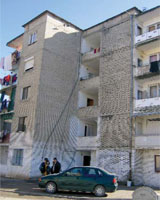Global Climate Change Program: Europe and Eurasia
  |
| Window weatherstripping at Omurtag Hospital in Bulgaria. |
Addressing the causes and effects of climate
change has been a key focus of USAID’s
development assistance for over a decade.
USAID has funded environmental programs that
have reduced greenhouse gas emissions while
promoting energy reforms to improve efficiency,
forest protection, biodiversity conservation, and other
development goals. This “multiple benefits” approach
to climate change helps developing and transition
countries achieve economic development without
sacrificing environmental protection. To help countries
address domestic and international climate change
priorities, USAID’s Global Climate Change Program
is active in more than 40 countries and, since 2001,
has dedicated over a billion U.S. dollars to promote:
clean energy technology; sustainable land use and
forestry; adaptation to climate change; and climate
science for decision-making.
The Europe and Eurasia (E&E) region has substantial
production of oil, gas, and coal, including mahor oil
and gas exports from Russia and Central Asia that
are important to global and regional energy security,
as well as to environmental systems affecting global
climate change. Other E&E countries are major
energy importers that are seeking to diversify supplies
and reduce their dependence on high-cost imports.
USAID’s assistance programs in this region have
focused on both systemic reform and institution-building,
as well as projects that promote more
efficient technologies and private investment. National
and regional projects have addressed five main areas:
developing sound national energy policies, energy
prices and legal/regulatory systems; improving efficiency
and reducing emissions in various sub-sectors; restructuring,
commercialization and privatization of energy
utilities and companies; closing high-risk nuclear power
plants and improving nuclear safety; and promoting
regional energy cooperation and the integration of
energy systems into Western Europe and international
energy markets.
USAID’s Global Climate Change Program is active
bilaterally in countries such as Albania, Armenia, Bosnia
and Herzegovina, Georgia, Kazakhstan, Kosovo, Kyrgyz
Republic, Macedonia, Montenegro, Tajikistan, and
Ukraine, and regionally in programs focused on the
Central Asian Republics, Southeast Europe and the
Black Sea.
Clean Energy Technology
  |
| Apartment building in Tirana, Albania, which was
retrofitted with roof insulation and double glazed windows |
New technologies and practices offer the prospect for
continued economic growth with reduced greenhouse
gas emissions. Recognizing that increased productivity
and efficiency are critical to economic growth, USAID
supports the commercialization, dissemination, and
widespread adoption of environmentally sound technologies.
Attracting private investment is essential to
popularizing such technologies as is a regulatory
framework for investment. In the E&E region, USAID
has been at the forefront of donor efforts to establish
sound legal and regulatory frameworks for investment
in the region and to create harmonized regional
markets, especially for electricity. USAID has helped build
separate, professional energy commissions in most
countries and has supported the Energy Regulators
Regional Association (ERRA), based in Hungary. ERRA is
widely recognized for its excellence in developing
and disseminating best practices on
tariff, licensing, and market issues.
Regulatory development and harmonization is being
pursued under the Athens Treaty for the Energy
Community, which went into effect in July 2006, and
commits the Balkan members to adopt EU energy,
competition, and environmental directives. USAID
programs have provided training and technical
advice to help establish the market designs and
rules that will facilitate transparent, efficient
commercial markets and attract initial investment
for system modernization and efficiency improvement.
Substantial efforts have been made and are
continuing to develop integrated, reliable
transmission grids in Southeast Europe, the Black
Sea, and Central Asia regions.
Energy efficiency opportunities in the E&E region
offer substantial and cost effective ways to reduce
greenhouse gas emissions as well as improve energy
security. As such, USAID has pursued a multi-faceted
approach. A basic aim has been to develop institutional
capacity, especially in nongovernmental
organization Energy Efficiency Centers and through
a regional network focused on municipal energy
efficiency. USAID has also worked to create industry
associations and to promote the creation of energy
service companies to carry out projects under
shared-savings schemes. Pilot projects have been
undertaken in schools (Macedonia), hospitals
(Armenia), municipal buildings (Bulgaria and
Serbia), and in industries (Ukraine) to demonstrate
the substantial returns from energy efficiency
investments. Collaboration with the World Bank
and European Bank for Reconstruction and
Development has led to a number of larger loans
by these institutions. A regional Development
Credit Authority in Southeast Europe to provide
loan guarantees to private lenders has operated
successfully in Bulgaria and is being expanded to
Macedonia and other countries in the region.
There is also a potential for coal bed methane in
the region, and USAID is supporting an activity
that uses horizontal drilling techniques to extract
methane and help improve the dangerous conditions
in Ukrainian mines.
Sustainable Land Use and Forestry
Promoting biodiversity conservation, improved
forest management, and sustainable agriculture,
USAID programs help mitigate climate change
by absorbing and storing carbon dioxide from
the atmosphere. They also help reduce the
vulnerability of ecosystems to climate change.
Reduced-impact logging of forests minimizes loss
of vegetative cover, for instance, which helps
stabilize the soil and controls erosion during rain
and wind storms. Reduced tillage and contour
planting by farmers increase soil organic carbon
and therefore enhance soil fertility, which helps
increase food security in developing countries.
Through the Forest Resources and Technologies
(FOREST) Project, USAID helped to preserve
Russian forests, and expand Russia’s carbon sink
through more effective fire and pest management
by encouraging more effective and innovative use
of timber and non-timber forest resources. The
FOREST Project also worked on reducing illegal
logging practices in the Russian Far East through
policy reforms. Similarly, in Bulgaria, USAID
worked closely with the National Eco Trust Fund
to build its capacity to establish and operate
the first Protected Areas Fund (PAF). PAF, one
of USAID’s legacies in Bulgaria, was formally
institutionalized as a sustainable mechanism for
financing protected areas activities.
Download the
Global Climate Change Program: Europe and Eurasia Brochure, May 2007 (PDF 231K)
Back to Top ^
|


